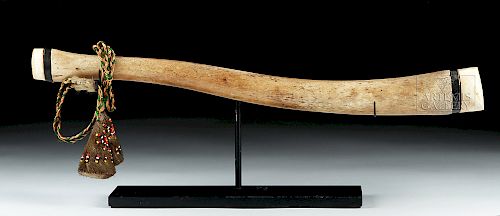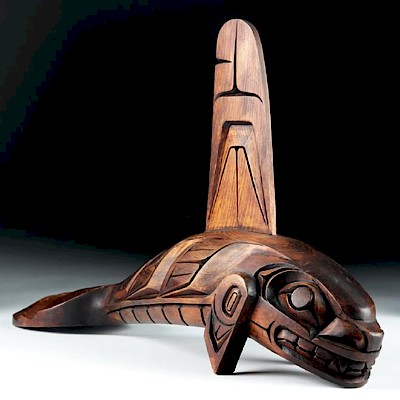Ancient Alaskan Fossilized Oosik w/ Baleen & Bone Caps
Lot 1
About Seller
Artemis Fine Arts
686 S Taylor Ave, Ste 106
Louisville, CO 80027
United States
Selling antiquities, ancient and ethnographic art online since 1993, Artemis Gallery specializes in Classical Antiquities (Egyptian, Greek, Roman, Near Eastern), Asian, Pre-Columbian, African / Tribal / Oceanographic art. Our extensive inventory includes pottery, stone, metal, wood, glass and textil...Read more
Estimate:
$750 - $1,200
Absentee vs Live bid
Two ways to bid:
- Leave a max absentee bid and the platform will bid on your behalf up to your maximum bid during the live auction.
- Bid live during the auction and your bids will be submitted real-time to the auctioneer.
Bid Increments
| Price | Bid Increment |
|---|---|
| $0 | $25 |
| $300 | $50 |
| $1,000 | $100 |
| $2,000 | $250 |
| $5,000 | $500 |
| $10,000 | $1,000 |
| $20,000 | $2,500 |
| $50,000 | $5,000 |
| $100,000 | $10,000 |
| $200,000 | $20,000 |
About Auction
By Artemis Fine Arts
May 24, 2018
Set Reminder
2018-05-24 10:00:00
2018-05-24 10:00:00
America/New_York
Bidsquare
Bidsquare : Northwest Coast, Tribal, & Pre-Columbian Art
https://www.bidsquare.com/auctions/artemis-gallery/northwest-coast-tribal-pre-columbian-art-3238
Featuring Pacific Northwest Coast Native American Art from respected collector / dealer, Joseph Alphabet. Artemis Fine Arts info@artemisfinearts.com
Featuring Pacific Northwest Coast Native American Art from respected collector / dealer, Joseph Alphabet. Artemis Fine Arts info@artemisfinearts.com
- Lot Description
North America, Alaska, ca. 5000 years ago, with Native American (Inuit, Yupik, and/or Alaskan native) modifications (caps and yo-yos) likely from the late 19th or early 20th century CE. A fossilized and highly polished walrus oosik (known as a baculum or penis bone) with two deep grooves, one near each end, filled with dark organic material. Both sides of the oosik have a dark-brown baleen strip, and a thick bone cap is inserted into each end slot. A strand of braided green, yellow, and light-brown thread is knotted around the smaller end, with a pair of attached Yupik seal-skin yoyos decorated with black, red, white, and yellow beaded adornments. This example is a rich, creamy brown, with the bone structure clear at the widest part of the bone. Custom museum-quality display stand included. Size: 17.25" L x 1.5" H (43.8 cm x 3.8 cm); 6" H (15.2 cm) on included custom stand.
The walrus is an iconic Arctic animal, and they are famous for having the largest baculum - known to native peoples in the Arctic as an "oosik" - of all land animals. The baculum is a bone found in the penis of many placental mammals, including some primates, which aids in maintaining stiffness during sexual reproduction. Fossilized bacula, which can be as long as 2 feet (60 cm), are often polished and used as clubs by native Alaskan cultures - they take these from sea lions, seals, polar bears, and, like this one, walruses. This is a beautiful example.
Provenance: private Newport Beach, California, USA collection
All items legal to buy/sell under U.S. Statute covering cultural patrimony Code 2600, CHAPTER 14, and are guaranteed to be as described or your money back.
A Certificate of Authenticity will accompany all winning bids.
We ship worldwide and handle all shipping in-house for your convenience.
#133567Age-commensurate surface wear, abrasions, and ossification as expected, with small fissures near both ends, and light discoloration. Excellent patina on surface from age and handling. Small collection sticker on one end.Condition
- Shipping Info
-
All shipping is handled in-house for your convenience. Your invoice from Artemis Gallery will include shipping calculation instructions. If in doubt, please inquire BEFORE bidding for estimated shipping costs for individual items.
-
- Buyer's Premium



 EUR
EUR CAD
CAD AUD
AUD GBP
GBP MXN
MXN HKD
HKD CNY
CNY MYR
MYR SEK
SEK SGD
SGD CHF
CHF THB
THB















